Two Centuries of Winter Temperature Variability Inferred from Betula ermanii Ring Widths near the Forests/Tundra Ecotone in the Changbai Mountain, China
Abstract
1. Introduction
2. Materials and Methods
2.1. Study Area and Sample Collection
2.2. Development of Ring-Width Chronologies
2.3. Climate Data
2.4. Statistical Analyses
3. Results
3.1. Relationship between Climate and Tree-Ring Width
3.2. Development of the Regression Model
3.3. The Result of Periodicity Analyses
4. Discussion
4.1. Climate–Growth Relationships
4.2. Temperature Variability through Time and Comparison with Historical Document Records
4.3. Comparison with Historical Records and Regional Comparison
4.4. Linkage with the Solar Activity and El Niño Southern Oscillation
4.5. The Altitude Differences of Start Time of the Recent Warming in Changbai Mountain
5. Conclusions
Author Contributions
Funding
Data Availability Statement
Acknowledgments
Conflicts of Interest
References
- IPCC (Intergovernmental Panel on Climate Change). Climate Change 2014: Mitigation of Climate Change; Cambridge University Press: Cambridge, UK, 2014; Available online: http://www.ipcc.ch/report/ar5/wg3 (accessed on 10 September 2014).
- Lloyd, A.H.; Bunn, A.G.; Berner, L. A latitudinal gradient in tree growth response to climate warming in the Siberian taiga. Glob. Chang. Biol. 2011, 17, 1935–1945. [Google Scholar] [CrossRef]
- Yu, D.; Wang, Q.; Wang, Y.; Zhou, W.; Ding, H.; Fang, X.; Jiang, S.; Dai, L. Climatic effects on radial growth of major tree species on Changbai Mountain. Ann. For. Sci. 2011, 68, 921–933. [Google Scholar] [CrossRef]
- Yu, D.; Liu, J.; Lewis, B.J.; Zhou, L.; Zhou, W.; Fang, X.; Wei, Y.; Jiang, S.; Dai, L. Spatial variation and temporal instability in the climate–growth relationship of Korean pine in the Changbai Mountain region of Northeast China. For. Ecol. Manag. 2013, 300, 96–105. [Google Scholar] [CrossRef]
- Zhang, X.; Bai, X.; Chang, Y.; Chen, Z. Increased sensitivity of Dahurian larch radial growth to summer temperature with the rapid warming in Northeast China. Trees 2016, 30, 1799–1806. [Google Scholar] [CrossRef]
- Lin, D.; Xia, J.; Wan, X.S. Climate warming and biomass accumulation of terrestrial plants: A meta-analysis. New Phytol. 2010, 188, 187–198. [Google Scholar] [CrossRef]
- Chen, P.Y.; Welsh, C.; Hamann, A. Geographic variation in growth response of Douglas-fir to interannual climate variability and projected climate change. Glob. Chang. Biol. 2010, 16, 3374–3385. [Google Scholar] [CrossRef]
- Huang, J.; Tardif, J.C.; Bergeron, Y.; Denneler, B.; Berninger, F.; Girardin, M.P. Radial growth response of four dominant boreal tree species to climate along a latitudinal gradient in the eastern Canadian boreal forest. Glob. Chang. Biol. 2010, 16, 711–731. [Google Scholar] [CrossRef]
- Sano, M.; Furuta, F.; Sweda, T. Summer temperature variations in southern Kamchatka as reconstructed from a 247-year tree-ring chronology of Betula ermanii. J. For. Res. 2010, 15, 234–240. [Google Scholar] [CrossRef]
- Li, C.; Wu, S.; Tao, P. Variability of climate–growth relationships along an elevation gradient in the Changbai Mountain, northeastern China. Trees 2011, 25, 1133–1139. [Google Scholar] [CrossRef]
- Camarero, J.J.; Gutiérrez, E. Pace and Pattern of Recent Tree line Dynamics: Response of Ecotones to Climatic Variability in the Spanish Pyrenees. Clim. Chang. 2004, 63, 181–200. [Google Scholar] [CrossRef]
- Handa, I.T.; Körner, C.; Hättenschwiler, S. Conifer stem growth at the altitudinal tree line in response to four years of CO2 enrichment. Glob. Chang. Biol. 2010, 12, 2417–2430. [Google Scholar] [CrossRef]
- Tomback, D.F.; Resler, L.M.; Keane, R.E.; Pansing, E.; Andrade, A.; Wagner, A. Community structure, biodiversity, and ecosystem services in treeline whitebark pine communities: Potential impacts from a non-native pathogen. Forests 2016, 7, 21. [Google Scholar] [CrossRef]
- Wang, H.; Shao, X.; Jiang, Y.; Fang, X.; Wu, S. The impacts of climate change on the radial growth of Pinus koraiensis along elevations of Changbai Mountain in northeastern China. For. Ecol. Manag. 2013, 289, 333–340. [Google Scholar] [CrossRef]
- Hao, Z.; Yu, D.; Yang, X.; Ding, Z. Analysis of plant community diversities and their gradient patterns on the northern slope of Changbai Mountain. Chin. J. Appl. Ecol. 2002, 7, 35–47. [Google Scholar]
- Zhang, J.; Chen, S.; Zhao, W. Regional Differences of Temperature Change in China in the Past 50 Years and Its Relationship with Global Climate Change. J. Arid Land Resour. Environ. 2006, 20, 1–6. (In Chinese) [Google Scholar]
- Jia, X.; Jin, H.; Zhao, Y.; Yin, H.; Liu, L.; Wang, C.; Cui, K.; Gu, X. Characteristics of Climate Change in Changbai Mountain from 1958 to 2015. J. Beihua Univ. (Nat. Sci.) 2017, 18, 727–731. [Google Scholar]
- Zhang, Y.J.; Dai, L.M.; Pan, J. The trend of tree line on the northern slope of Changbai Mountain. J. For. Res. 2001, 12, 97–100. (In Chinese) [Google Scholar]
- Fritts, H.C. Tree Rings and Climate; Academic Press: New York, NY, USA, 1976. [Google Scholar] [CrossRef]
- Wilson, R.; Wiles, G.; D’Arrigo, R.; Zweck, C. Cycles and Shifts: 1300 Years of Multi-Decadal Temperature Variability in the Gulf of Alaska. Clim. Dyn. 2007, 28, 425–440. [Google Scholar] [CrossRef]
- Mann, M.E.; Zhang, Z.; Rutherford, S. Global signatures and dynamical origins of the Little Ice Age and Medieval Climate Anomaly. Science 2009, 326, 1256. [Google Scholar] [CrossRef]
- Tian, Q.; Gou, X.H.; Zhang, Y.; Wang, Y.S.; Fan, Z. May–June mean temperature reconstruction over the past 300 years based on tree rings in the Qilian Mountains of the northeastern Tibetan plateau. IAWA J. 2009, 30, 421–434. [Google Scholar] [CrossRef]
- Cook, E.R.; Anchukaitis, K.J.; Buckley, B.M. Asian monsoon failure and mega drought during the last millennium. Science 2010, 328, 486–489. [Google Scholar] [CrossRef] [PubMed]
- Davi, N.; Jacoby, G.; Fang, K. Reconstructing drought variability for Mongolia based on a large-scale tree ring network: 1520–1993. J. Geophys. Res. Atmos. 2010, 115, 1842–1851. [Google Scholar] [CrossRef]
- Bao, G.Y.; Liu, Y.; Linderholm, H.W. April–September mean maximum temperature inferred from Hailar pine (Pinus sylvestris var. mongolica) tree rings in the Hulunbuir region, Inner Mongolia, back to 1868 AD. Palaeogeogr. Palaeoclimatol. Palaeoecol. 2012, 313, 162–172. [Google Scholar] [CrossRef]
- Wang, W.W.; Zhang, J.H.; Dai, G.H. Tree-ring based temperature variability in autumn over the past 240 years in Changbai Mountain. Chin. J. Ecol. 2012, 31, 787–793. (In Chinese) [Google Scholar]
- Wiles, G.C.; Solomina, O.; D’Arrigo, R.; Anchukaitis, K.J.; Gensiarovsky, Y.V.; Wiesenberg, N. Reconstructed summer temperatures over the last 400 years based on larch ring widths: Sakhalin Island, Russian Far East. Clim. Dyn. 2015, 45, 397–405. [Google Scholar] [CrossRef]
- Shi, S.; Li, J.; Shi, J.; Zhao, Y.; Huang, G. Three centuries of winter temperature change on the southeastern Tibetan Plateau and its relationship with the Atlantic Multidecadal Oscillation. Clim. Dyn. 2016, 52, 1533–1545. [Google Scholar] [CrossRef]
- Cai, Q.; Liu, Y. Two centuries temperature variations over subtrop-ical southeast China inferred from Pinus taiwanensis Hayata tree-ring width. Clim. Dyn. 2017, 48, 1813–1825. [Google Scholar] [CrossRef]
- Cai, Q.; Liu, Y.; Duan, B.; Sun, C. Regional difference of the start time of the recent warming in Eastern China: Prompted by a 165-year temperature record deduced from tree rings in the Dabie Mountains. Clim. Dyn. 2018, 50, 2157–2168. [Google Scholar] [CrossRef]
- Wang, Y.; Liu, Y.; Zhang, H.; Wang, H.; Guo, J. Temperature variability inferred from tree-ring records in Weichang region, China, and its teleconnection with large-scale climate forcing. Clim. Dyn. 2019, 52, 1533–1545. [Google Scholar] [CrossRef]
- Zhu, H.F.; Fang, X.Q.; Shao, X.M. Tree ring-based February–April temperature reconstruction for Changbai Mountain in Northeast China and its implication for East Asian winter monsoon. Clim. Past Discuss. 2009, 5, 661–666. [Google Scholar] [CrossRef]
- Zhu, L.; Li, S.; Wang, X. Tree-ring reconstruction of February-March mean minimum temperature back to 1790 AD in Yichun, Northeast China. Quat. Sci. 2015, 35, 1175–1184. (In Chinese) [Google Scholar]
- Holmes, R.L. Computer-Assisted Quality Control in Tree-Ring Dating and Measurement. Tree-Ring Bull. 1983, 44, 69–75. [Google Scholar] [CrossRef]
- Cook, E.R.; Kairiukstis, L.A. (Eds.) Methods of Dendrochronology: Applications in the Environmental Science; Kluwer Academic Publishers: Dordrecht, The Netherlands; International Institute for Applied Systems Analysis: Dordrecht, The Netherlands, 1990. [Google Scholar]
- Buras, A.; Zang, C.; Menzel, A. Testing the stability of transfer functions. Dendrochronologia 2017, 42, 56–62. [Google Scholar] [CrossRef]
- Trapletti, A.; Hornik, K. T Series: Time Series Analysis and Computational Finance, R package version 0.10-46; R Foundation for Statistical Computer: Vienna, Austria, 2018. [Google Scholar]
- Biondi, F.; Waikul, K. DENDROCLIM2002: A C++ program for statistical calibration of climate signals in tree-ring chronologies. Comput. Geosci. 2004, 30, 303–311. [Google Scholar] [CrossRef]
- Cook, E.R.; Meko, D.M.; Stahle, D.W.; Cleavel, M.K. Drought reconstructions for the continental United States. J. Clim. 1999, 12, 1145–1162. [Google Scholar] [CrossRef]
- Mann, M.E.; Lees, J.M. Robust estimation of background noise and signal detection in climatic time series. Clim. Chang. 1996, 33, 409–445. [Google Scholar] [CrossRef]
- Wen, K.G. China Meteorological Disaster in Jilin Province; China Meteorological Press: Beijing, China, 2008. (In Chinese) [Google Scholar]
- Oberhuber, W.; Kofler, W.; Pfeifer, K.; Seeber, A.; Gruber, A.; Wieser, G. Long-term changes in tree-ring–climate relationships at Mt. Patscherkofel (Tyrol, Austria) since the mid-1980s. Trees 2008, 22, 31–40. [Google Scholar] [CrossRef] [PubMed]
- Carrer, M.; Nola, P.; Motta, R. Contrasting tree-ring growth to climate responses of Abies alba toward the southern limit of its distribution area. Oikos 2010, 119, 1515–1525. [Google Scholar] [CrossRef]
- Wang, X.M.; Zhao, X.H.; Gao, L.S. Climatic response of Betula ermanii along an altitudinal gradient in the northern slope of Changbai Mountain, China. Dendrobiology 2013, 70, 99–107. [Google Scholar] [CrossRef]
- Zhang, T.; Yuan, Y.; Wei, W.; Yu, S.; Zhang, R.; Shang, H.; Chen, F.; Fan, Z.; Qin, L. Tree-ring-based temperature reconstruction for the northern Greater Higgnan Mountains, China, since A.D. 1717. Int. J. Climatol. 2013, 33, 422–429. [Google Scholar] [CrossRef]
- Su, H.; Axmacher, J.C.; Yang, B.; Sang, W. Differential radial growth response of three coexisting dominant tree species to local and large-scale climate variability in a subtropical evergreen broad-leaved forest of China. Ecol. Res. 2015, 30, 745–754. [Google Scholar] [CrossRef]
- Buma, B.; Hennon, P.E.; Harrington, C.A.; Popkin, J.R.; Krapek, J.; Lamb, M.S.; Oakes, L.E.; Saunders, S.; Zeglen, S. Emerging climate-driven disturbance processes: Widespread mortality associated with snow-to-rain transitions across 10° of latitude and half the range of a climate-threatened conifer. Glob. Chang. Biol. 2017, 23, 2903–2914. [Google Scholar] [CrossRef] [PubMed]
- Lean, J.; Rind, D. Evaluating sun–climate relationships since the Little Ice Age. J. Atmos. Sol. Terr. Phys. 1999, 61, 25–36. [Google Scholar] [CrossRef]
- Beer, J.; Mende, W.; Stellmacher, R. The role of the sun in climatic forcing. Quat. Sci. Rev. 2000, 19, 403–415. [Google Scholar] [CrossRef]
- Christiansen, B.; Ljungqvist, F.C. The extra-tropical Northern Hemisphere temperature in the last two millennia: Reconstructions of low-frequency variability. Clim. Past 2012, 8, 765–786. [Google Scholar] [CrossRef]
- Wagner, S.; Zorita, E. The influence of volcanic, solar and CO2 forcing on the temperatures in the Dalton Minimum (1790–1830): A model study. Clim. Dyn. 2005, 25, 205–218. [Google Scholar] [CrossRef]
- Ljungqvist, F.C. A new reconstruction of temperature variability in the extra-tropical northern hemisphere during the last two millennia. Geogr. Ann. Ser. A Phys. Geogr. 2010, 92, 339–351. [Google Scholar] [CrossRef]
- Zharkova, V.V.; Shepherd, S.J.; Popova, E.; Zharkov, S. Reinforcing a Double Dynamo Model with Solar-Terrestrial Activity in the Past Three Millennia. Proc. Int. Astron. Union 2017, 13, 211–215. [Google Scholar] [CrossRef]
- Friis-Christensen, E. Solar activity variations and global temperature. Energy 1993, 18, 1273–1284. [Google Scholar] [CrossRef]
- Ogurtsov, M.G.; Nagovitsyn, Y.A.; Kocharov, G.E.; Jungner, H. Long-period cycles of the Sun’s activity recorded in direct solar data and proxies. Sol. Phys. 2002, 211, 371–394. [Google Scholar] [CrossRef]
- Yi, L.; Yu, H.; Ge, J.; Lai, Z.; Xu, X.; Qin, L.; Peng, S. Reconstructions of annual summer precipitation and temperature in north-central China since 1470 AD based on drought/flood index and tree-ring records. Clim. Chang. 2012, 110, 469–498. [Google Scholar] [CrossRef]
- Auer, G.; Piller, W.E.; Harzhauser, M. Two distinct decadal and centennial cyclicities forced marine upwelling intensity and precipitation during the late Early Miocene in central Europe. Clim. Past Discuss. 2014, 10, 1223–1264. [Google Scholar] [CrossRef]
- Wang, Y.; Liu, Y. Reconstruction of March–June precipitation from tree rings in central Liaoning, China. Clim. Dyn. 2016, 49, 3111–3121. [Google Scholar] [CrossRef]
- Herrera, V.M.V.; Mendoza, B.; Herrera, G.V. Reconstruction and prediction of the total solar irradiance: From the Medieval Warm Period to the 21st century. New Astron. 2015, 34, 221–233. [Google Scholar] [CrossRef]
- Su, M.F.; Wang, H.J. Relationship and its instability of ENSO—Chinese variations in droughts and wet spells. Sci. China Ser. D 2007, 50, 145–152. [Google Scholar] [CrossRef]
- Hocke, K. QBO in solar wind speed and its relation to ENSO. J. Atmos. Sol.-Terr. Phys. 2009, 71, 216–220. [Google Scholar] [CrossRef]
- Gergis, J.L.; Fowler, A.M. A history of ENSO events since A.D. 1525: Implications for future climate change. Clim. Chang. 2009, 92, 343–387. [Google Scholar] [CrossRef]
- Wu, R.; Wang, B.A. Contrast of the East Asian Summer Monsoon-ENSO Relationship between 1962–77 and 1978–93. J. Clim. 2002, 15, 3266–3279. [Google Scholar] [CrossRef]
- Lu, R.Y. Interannual variation of North China rainfall in rainy season and SSTs in the equatorial eastern Pacific. Chin. Sci. Bull. 2005, 50, 2069–2073. [Google Scholar] [CrossRef]
- Li, C.Y. Interaction between anomalous winter monsoon in East Asia and El Nio events. Adv. Atmos. Sci. 1990, 7, 36–46. [Google Scholar] [CrossRef]
- Wen, C.; Lan, X.Q.; Lin, W.; Yin, M. The combined effects of the ENSO and the Arctic Oscillation on the winter climate anomalies in East Asia. Sci. Bull. 2013, 58, 1355–1362. [Google Scholar]
- Lu, R.; Jia, F.; Gao, S.; Shang, Y.; Chen, Y. Tree-ring reconstruction of January–March minimum temperatures since 1804 on Hasi Mountain, northwestern China. J. Arid Environ. 2016, 127, 66–73. [Google Scholar] [CrossRef]
- Sun, L.H.; Zhao, Z.G. China’s warm winter and its causes. Meteorological 2004, 30, 57–60. (In Chinese) [Google Scholar]
- Chen, W. The impacts of El Niño and La Niña on the cycle of East Asian winter and summer monsoon. Chin. J. Atmos. Sci. 2002, 26, 595–610. [Google Scholar] [CrossRef]
- Shao, X.; Wu, X. Reconstruction of climate change on Changbai Mountain, Northeast China using tree-ring data. Quat. Sci. 1997, 1, 76–85. (In Chinese) [Google Scholar]
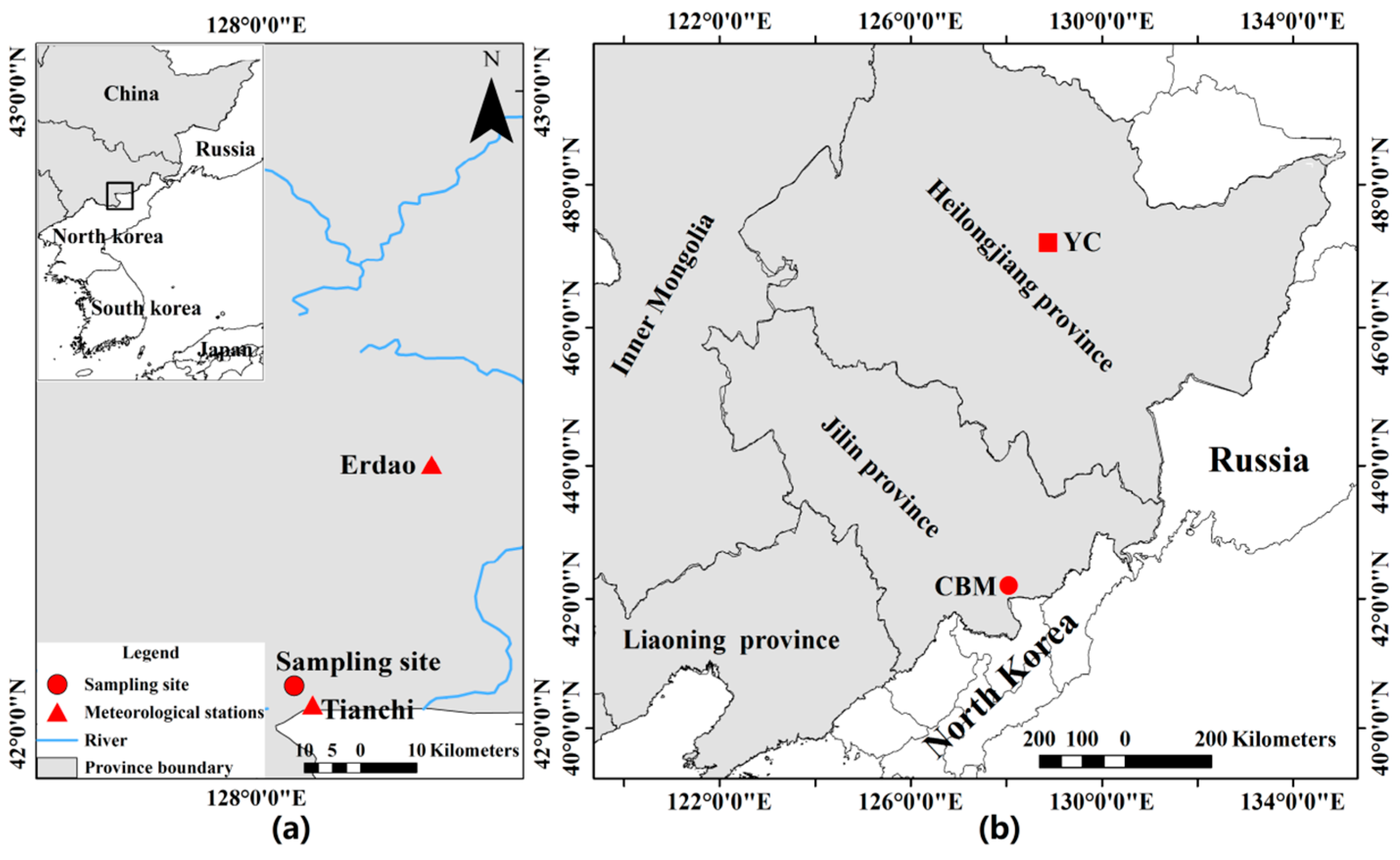
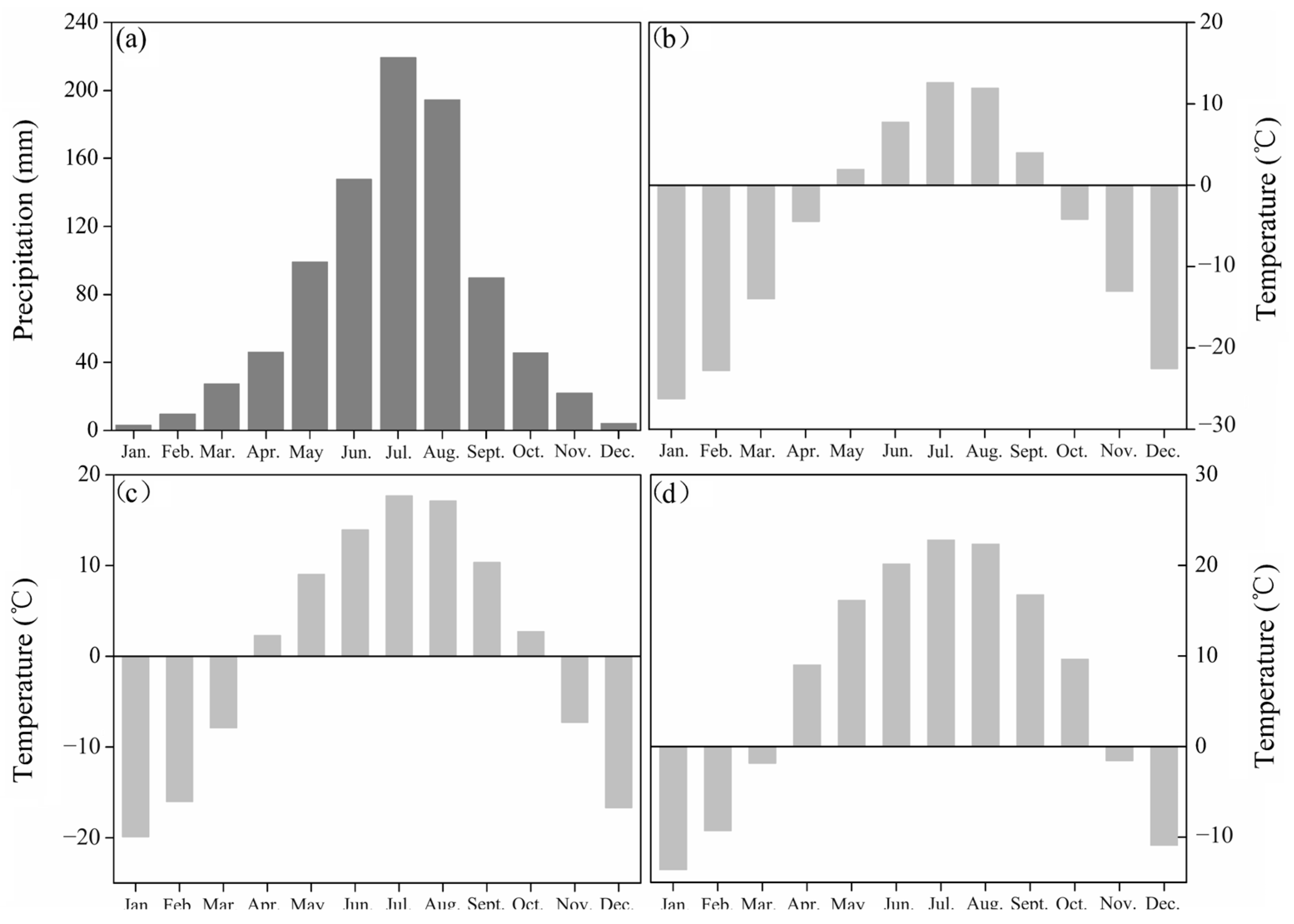
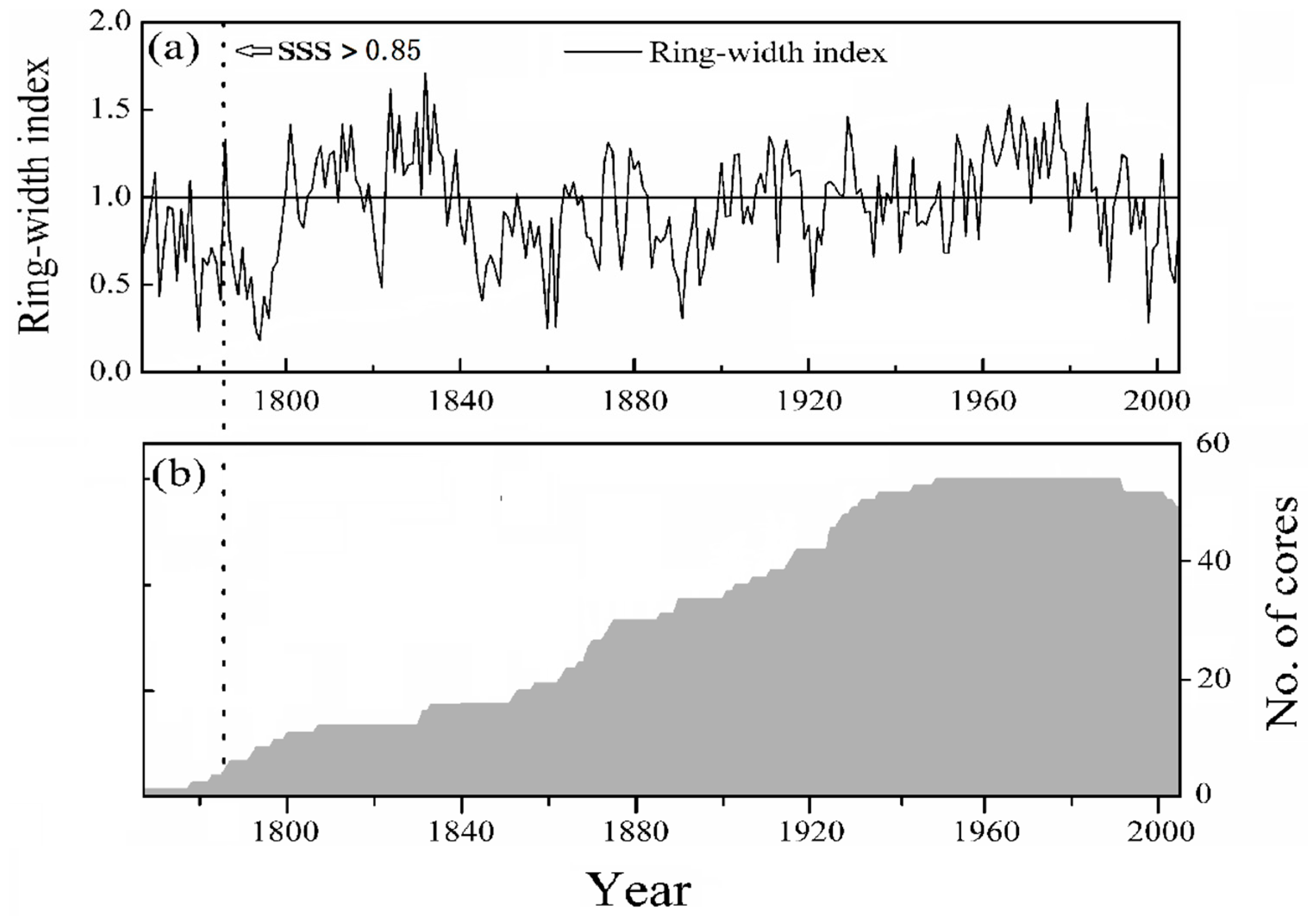

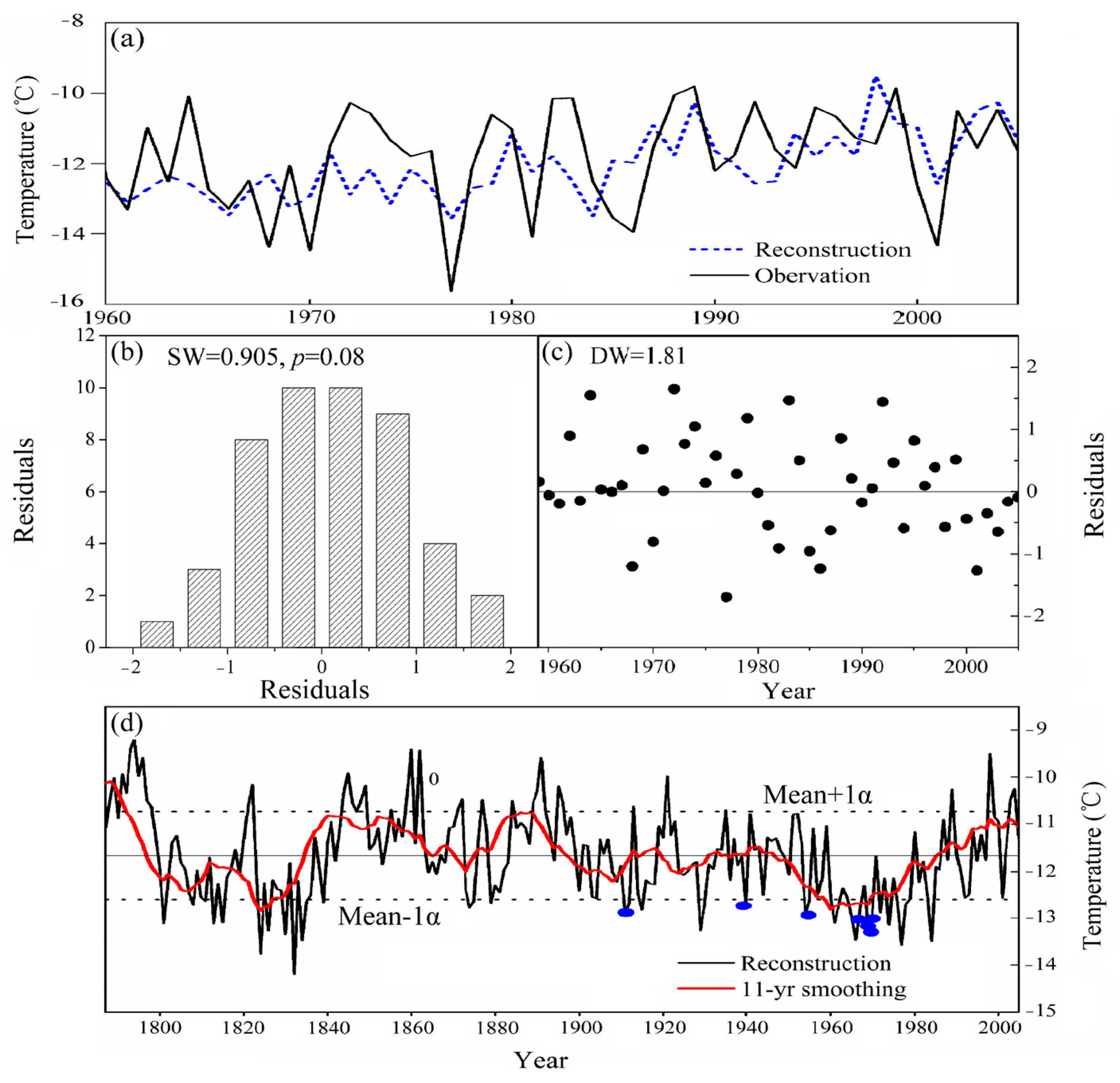

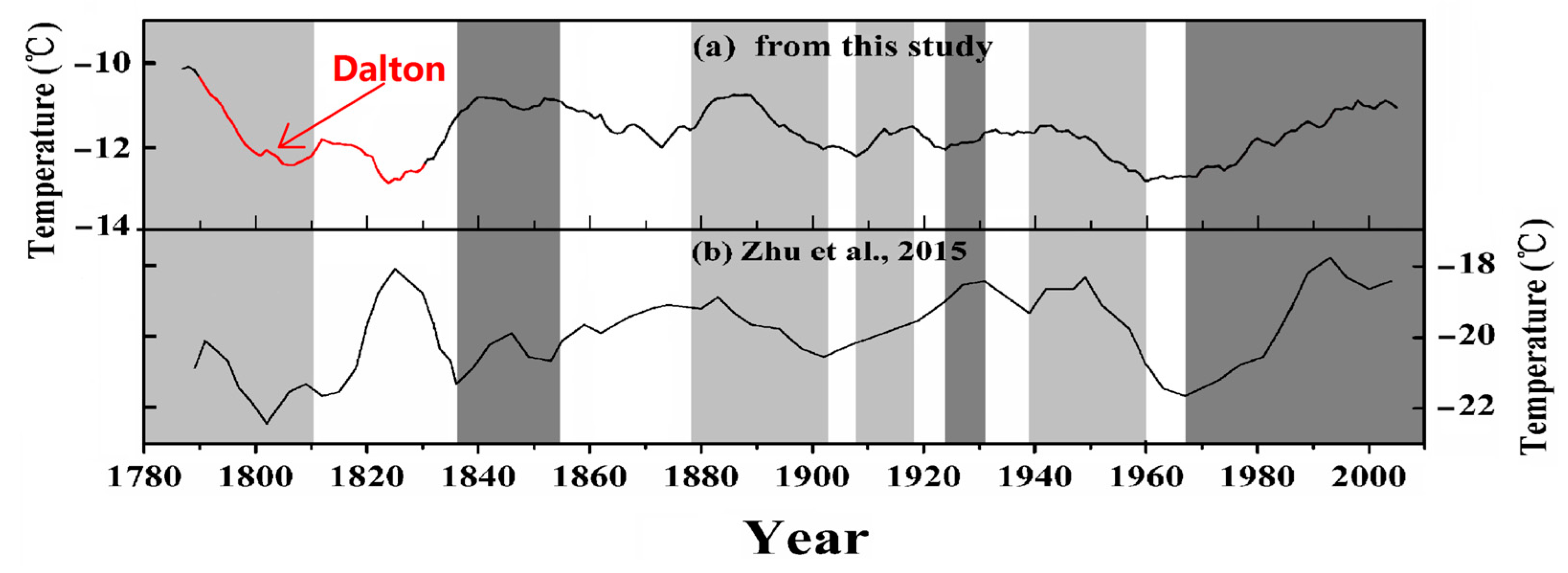
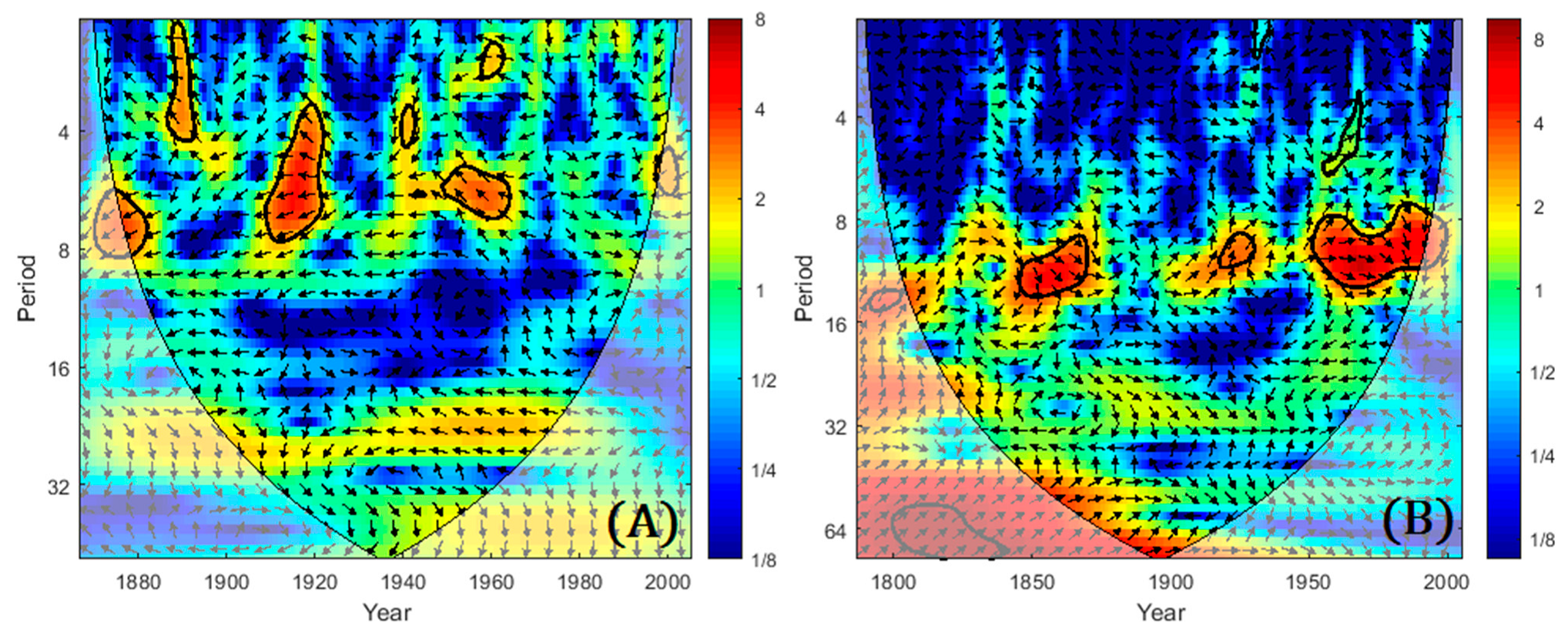
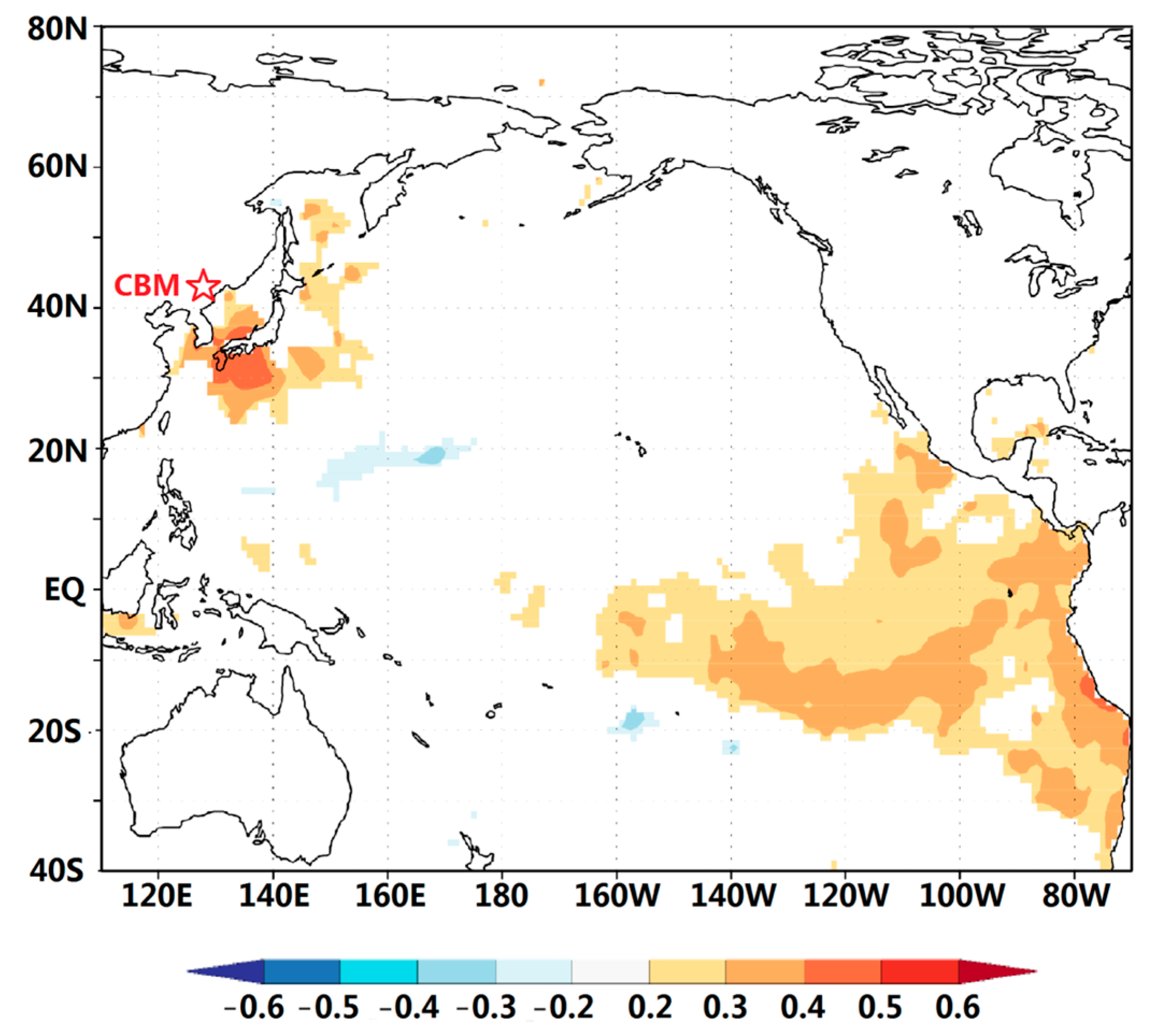
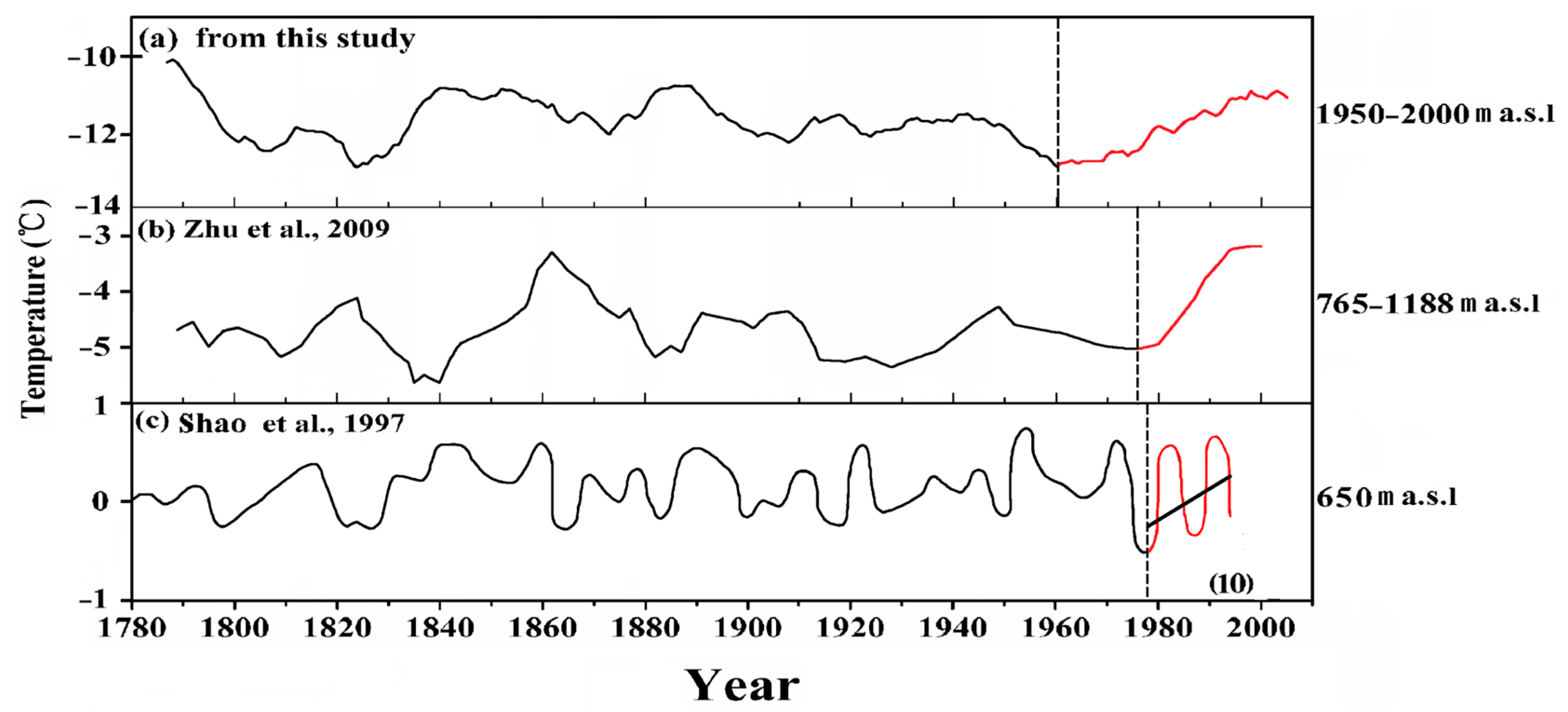
| Statistic | STD |
|---|---|
| Mean sensitivity | 0.33 |
| First-order autocorrelation | 0.68 |
| Standard deviation | 0.21 |
| Mean ring width (mm) | 0.67 |
| Number of trees/cores | 30/55 |
| % Missing rings | 0.25 |
| Mean correlation within trees | 0.70 |
| Signal-to-noise ratio (SNR) | 10.3 |
| Mean ring width (mm) | 0.66 |
| First year where SSS > 0.85 (number of trees) | 1787 (7) |
| Months | Tmax | Tmean | Tmin | Pre | PDSI |
|---|---|---|---|---|---|
| p12–c1 | −0.60 * | −0.52 * | −0.40 * | 0.16 * | 0.39 * |
| p9–p12 | −0.17 | −0.18 | −0.17 | 0.37 * | 0.49 * |
| p9–p10 | −0.02 | 0.01 | 0.02 | 0.33 * | 0.25 |
| p9–p11 | −0.10 | −0.07 | −0.04 | 0.36 * | 0.42 * |
| p10–p11 | −0.15 | −0.11 | −0.07 | 0.37 * | 0.44 * |
| p11–p12 | −0.31 * | −0.36 * | −0.37 * | 0.41 * | 0.53 * |
| Calibration | Verification | |||||||||
|---|---|---|---|---|---|---|---|---|---|---|
| Time Span | r | R2 | Time Span | r | RE | CE | ST | PMT | DW | RMSE |
| 1960–1982 | −0.57 a | 0.32 a | 1983–2005 | −0.64 a | 0.30 a | 0.19 a | (17+/6−) a | 2.6 a | 1.9 | 0.75 |
| 1983–2005 | −0.64 a | 0.41 a | 1960–1982 | −0.57 a | 0.23 a | 0.26 a | (17+/5−) a | 3.3 a | 1.82 | 0.72 |
| 1960–2005 | −0.60 a | 0.36 a | 0.27 a | 3.5 a | 1.81 | 0.70 | ||||
| Recorded Events in Historical Documents | Cold Year | Temperature (°C) | Warm Year | Temperature (°C) |
|---|---|---|---|---|
| 1840 | −14.38 | 1794 | −9.19 | |
| 1832 | −14.20 | 1860 | −9.41 | |
| 1824 | −13.77 | 1862 | −9.43 | |
| 1977 | −13.57 | 1793 | −9.44 | |
| 1984 | −13.50 | 1998 | −9.51 | |
| 1834 | −13.48 | 1891 | −9.58 | |
| 1966 | −13.47 | 1796 | −9.59 | |
| 1830 | −13.35 | 1845 | −9.91 | |
| 1837 | −13.28 | 1791 | −9.94 | |
| 1826 | −13.27 | 1795 | −9.98 | |
| 1929 | −13.27 | 1921 | −9.98 | |
| (1969 AD) Jilin Province: Severe low temperatures occurred throughout the province in this year | 1969 | −13.26 | 1789 | −10.02 |
| 1974 | −13.15 | 1822 | −10.16 | |
| 1813 | −13.12 | 1849 | −10.18 | |
| 1801 | −13.12 | 1895 | −10.19 | |
| 1961 | −13.11 | 2004 | −10.24 | |
| 1815 | −13.10 | 1989 | −10.26 | |
| (1965 AD) Inner Mongolia: snow occurred in eastern Inner Mongolia in winter, such as Hulunbuir, Hinggan League, Tongliao, etc. | 1965 | −12.96 | 1890 | −10.31 |
| 1841 | −12.94 | 1844 | −10.32 | |
| (1954 AD) Jilin Province: Severe low temperatures occurred throughout the province in this year | 1954 | −12.94 | 1792 | −10.34 |
| (1970 AD) Jilin Province: Heavy snow occurred in the Hailong area in December | 1970 | −12.93 | 1859 | −10.42 |
| (1911 AD) Jilin Province: Severe low temperatures occurred throughout the province in this year | 1911 | −12.90 | 1788 | −10.46 |
| (1972 AD) Jilin Province: Severe low temperatures occurred throughout the province in this year | 1972 | −12.89 | 1872 | −10.47 |
| 1915 | −12.83 | 1877 | −10.48 | |
| 1967 | −12.80 | 2003 | −10.49 | |
| 1842 | −12.79 | 1797 | −10.49 | |
| 1874 | −12.79 | 1848 | −10.49 | |
| 1962 | −12.73 | 1884 | −10.50 | |
| (1940 AD) Jilin Province: Heavy snow occurred in the Baicheng area in December | 1940 | −12.73 | 1896 | −10.53 |
| 1808 | −12.72 | 1846 | −10.54 | |
| 1930 | −12.71 | 1889 | −10.55 | |
| 1798 | −10.62 | |||
| 1913 | −10.62 | |||
| 1821 | −10.62 | |||
| 1871 | −10.69 | |||
| 1935 | −10.71 |
Disclaimer/Publisher’s Note: The statements, opinions and data contained in all publications are solely those of the individual author(s) and contributor(s) and not of MDPI and/or the editor(s). MDPI and/or the editor(s) disclaim responsibility for any injury to people or property resulting from any ideas, methods, instructions or products referred to in the content. |
© 2024 by the authors. Licensee MDPI, Basel, Switzerland. This article is an open access article distributed under the terms and conditions of the Creative Commons Attribution (CC BY) license (https://creativecommons.org/licenses/by/4.0/).
Share and Cite
Li, S.; Cui, X.; Jiang, Y. Two Centuries of Winter Temperature Variability Inferred from Betula ermanii Ring Widths near the Forests/Tundra Ecotone in the Changbai Mountain, China. Forests 2024, 15, 220. https://doi.org/10.3390/f15010220
Li S, Cui X, Jiang Y. Two Centuries of Winter Temperature Variability Inferred from Betula ermanii Ring Widths near the Forests/Tundra Ecotone in the Changbai Mountain, China. Forests. 2024; 15(1):220. https://doi.org/10.3390/f15010220
Chicago/Turabian StyleLi, Siwen, Xiaoyang Cui, and Yangao Jiang. 2024. "Two Centuries of Winter Temperature Variability Inferred from Betula ermanii Ring Widths near the Forests/Tundra Ecotone in the Changbai Mountain, China" Forests 15, no. 1: 220. https://doi.org/10.3390/f15010220
APA StyleLi, S., Cui, X., & Jiang, Y. (2024). Two Centuries of Winter Temperature Variability Inferred from Betula ermanii Ring Widths near the Forests/Tundra Ecotone in the Changbai Mountain, China. Forests, 15(1), 220. https://doi.org/10.3390/f15010220






